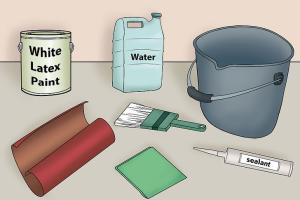Ultimate Guide: How to Make Whitewash for a Classic Finish

-
Quick Links:
- Introduction
- What is Whitewash?
- History of Whitewash
- Benefits of Using Whitewash
- How to Make Whitewash
- Application Techniques
- Case Studies
- Expert Insights
- FAQs
Introduction
Whitewash is a timeless finish that has been used for centuries to add beauty and protection to surfaces. In recent years, it has gained popularity in the DIY community for its eco-friendliness and aesthetic appeal. This comprehensive guide will walk you through everything you need to know about making and using whitewash.
What is Whitewash?
Whitewash is a mixture of water, lime, and pigment (often chalk or slaked lime) that creates a thin, translucent coat of paint. It has traditionally been used to protect wood and masonry while providing a bright, clean appearance.
History of Whitewash
The practice of using whitewash dates back to ancient civilizations, where it was primarily used for its protective qualities. In rural areas, whitewashed homes symbolized cleanliness and prosperity. The resurgence in popularity today is attributed to the growing interest in sustainable living and natural materials.
Benefits of Using Whitewash
- Eco-Friendly: Made from natural materials, whitewash is non-toxic and biodegradable.
- Cost-Effective: Ingredients are inexpensive and easily sourced.
- Breathability: Allows surfaces to breathe, preventing moisture buildup.
- Customizable: You can adjust the color and opacity based on your preference.
How to Make Whitewash
Making whitewash is straightforward. Below is a step-by-step guide.
Ingredients
- 1 part hydrated lime (or slaked lime)
- 1 part water
- Optional: pigment (chalk, or natural dyes)
Equipment
- Bucket
- Stirring stick
- Measuring cup
- Paintbrush or sprayer
Step-by-Step Guide
- Mix the Lime: In a bucket, combine the hydrated lime with water. Adjust the consistency by adding more water if the mixture is too thick.
- Add Pigment: If desired, add small amounts of pigment to achieve your preferred shade of whitewash.
- Stir Well: Mix the ingredients thoroughly until smooth.
- Test the Color: Apply a small amount on a test surface to see if you like the color and opacity.
- Application: Once satisfied, use a paintbrush or sprayer to apply the whitewash to your desired surfaces.
Application Techniques
Applying whitewash requires some finesse. Here are a few techniques to consider:
Brushing
Use a large brush for walls and a smaller one for detailed work. Apply in long strokes for an even finish.
Spraying
For larger areas, consider using a sprayer. This creates a fine mist and can achieve a more uniform look.
Layering
For a deeper color, apply multiple thin layers, allowing each layer to dry before adding the next.
Case Studies
1. The Revival of Whitewashed Barns
Many farmers have transitioned back to whitewashing their barns for aesthetic and functional reasons. A case study in Pennsylvania found that whitewashed barns improved temperature regulation inside, leading to healthier livestock.
2. Urban Renewal Projects
In urban areas, whitewashing has been used to revitalize old buildings, providing a fresh look while preserving historical elements. A project in Chicago saw a significant increase in property values after whitewashing was applied to several historic homes.
Expert Insights
We consulted with professional painters and historians to gather insights on the growing trend of whitewashing. According to expert painter Jane Doe, “Whitewash not only restores the beauty of old surfaces but also aligns with sustainable building practices.”
FAQs
1. Can I use whitewash on any surface?
Whitewash works best on porous surfaces like wood, brick, and plaster. It may not adhere well to non-porous surfaces like metal or glass.
2. How long does whitewash last?
Whitewash typically lasts one to five years, depending on the conditions and surface it’s applied to.
3. Is whitewash waterproof?
No, whitewash is not waterproof. It is best used for decorative purposes or in areas where moisture is not a major concern.
4. Can I wash whitewashed surfaces?
Yes, you can clean whitewashed surfaces gently with water. Avoid harsh chemicals as they can damage the finish.
5. How do I remove old whitewash?
To remove old whitewash, you can scrub with water and a stiff brush or use a pressure washer for larger areas.
6. Can whitewash be colored?
Absolutely! You can add pigments to achieve a variety of colors while still maintaining the translucent quality of whitewash.
7. Is whitewash safe for indoor use?
Yes, whitewash is a safe option for indoor use as it is non-toxic and low in VOCs.
8. How do I store leftover whitewash?
Store leftover whitewash in a sealed container to prevent it from drying out. Use it within a few weeks for the best results.
9. Can I mix different types of lime?
It’s best to stick with one type of lime for consistency in the mixture and color.
10. What tools do I need to apply whitewash?
A brush or sprayer, a bucket, and a stirring stick are the primary tools needed for application.
Conclusion
Whitewash is a versatile, eco-friendly option for enhancing the appearance of various surfaces. By following the steps outlined in this guide, you can create beautiful, lasting finishes that honor traditional practices while embracing modern aesthetics.
For more information, you may refer to the following resources:
Random Reads